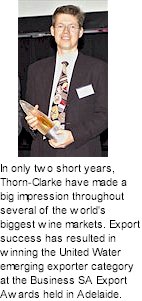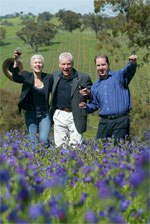


The Barossa Valley was settled in the early 1840s by small farmers and artisans seeking religious freedom from their native Silesia. The warm, fertile valley was ideal for ripening winegrapes and Australia's largest wineries made their headquarters amongst the vineyards. In the cooler ranges above the Barossa, known as Eden Valley, English settlers created large pastoral runs for sheep and cattle, but also planted vineyards to ensure a supply of table wine.

In the early 1990s Australia created a Geographic Indication for each wine region so that they were recognised under international law. The Barossa was proclaimed a wine zone and within it, the two regions of Barossa Valley and Eden Valley. Over two centuries the Barossa has become the headquarters of the Australian wine industry and the most famous Australian zone internationally. Thorn-Clarke take a long-term view of the future and their goal is unashamedly to be still growing grapes and making wine for another six generations. They recognise and value the role that their suppliers, distributors, retailers and customers play in this goal and seek to develop sustainable partnerships based on loyalty, trust and quality.
The name Thorn-Clarke derives literally from the relationship between two long time Barossa families. The winery owners are David and Cheryl Clarke (nee Thorn) and their son Sam is manager of the winery. Cheryl's brother, David Thorn manages the Mount Crawford and Kabininge vineyards for Thorn-Clarke Wines. Her father Ron Thorn has one of the oldest Shiraz vineyards in Australia and possibly the world on the Thorn family property 'Clifton' outside of Angaston. Earliest records show this old vineyard was in existence in 1854.
Husband and wife, David and Cheryl Clarke both have deep family roots in the Barossa. Cheryl Clarke's family, the Thorn's, have been grape growers in the Barossa since the 1870s. David Clarke's family were pioneers in the Barossa as well but most famously in the mining of gold from the Barossa Goldfields. One of his ancestors was James Goddard who was the responsible for opening the Lady Alice gold mine in the Barossa goldfields and which was the largest gold mine in South Australia at the time. It has been David's love of the wine industry that saw the planting of the Kabininge vineyard outside of Tanunda in 1987. The planting of the Kabininge vineyard represented the start of a deeper involvement by the family in the Barossa wine industry.

The team at Thorn-Clarke share a quality objective, to be a premium wine producer for a very long time, producing quality high value wines. Right from the time when their first vineyards were established Thorn-Clarke have been extremely thorough in ensuring all elements were just right. All four of the Thorn-Clarke vineyards have been selected to ensure they can provide the ideal growing conditions for each variety. The release of wines is never rushed. Thorn-Clarke await for the optimal vine age to ensure top quality fruit. The attention to detail carries through from the grapegrowing to the winemaking side, ensuring that the wines over deliver in quality across a number of different price points.
Thorn-Clarke today are accumulating a terrific run of achievements on the back of some fantastic awards and accolades. It seemed to all start with the 2004 Shotfire Ridge Quartage being awarded the top wine of the Adelaide Wine Show and has progressed from there with trophys and gold medals at other wine shows, high scores from Parker and Wine Spectator in the USA and a resultant increase in interest in all the Thorn-Clarke wines from all over the world. Quality means showcasing the best that the Barossa has to offer and this has been achieved through a strategic vineyard development plan.
The Thorn-Clarke vineyard development plan was started more than twenty years ago and will continue into the future. The four Thorn-Clarke vineyards highlight the individual micro-climates of the Barossa with four quite different terroirs which are brought to the fore in single vineyard wines, or taken in parcels for cross-terroir blending to achieve complexity and interest.
St Kitts and Truro are cooler vineyards. With lower rainfall, these northern Barossa sites totalling 103 hectares, are at an elevation of between 380 and 410 metres. Mt Crawford is a late ripening vineyard, enjoying high rainfall. With elevations as high as 475 metres above sea level, this 37 hectare Eden Valley site can easily be confused with the Adelaide Hills, which is after all just across the range. Kabininge in stark contrast, is 33 hectares of true Barossa Valley floor terroir. At just 270 metres above sea level, red winegrape varietals ripen easily here. Milton Park is located in classic Eden Valley country, between Angaston and Keyneton, sitting at an elevation of between 330 and 400 metres above sea level.
